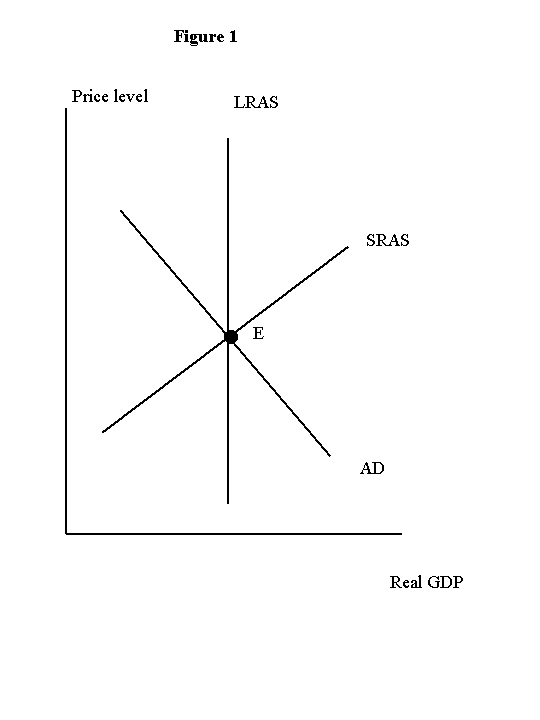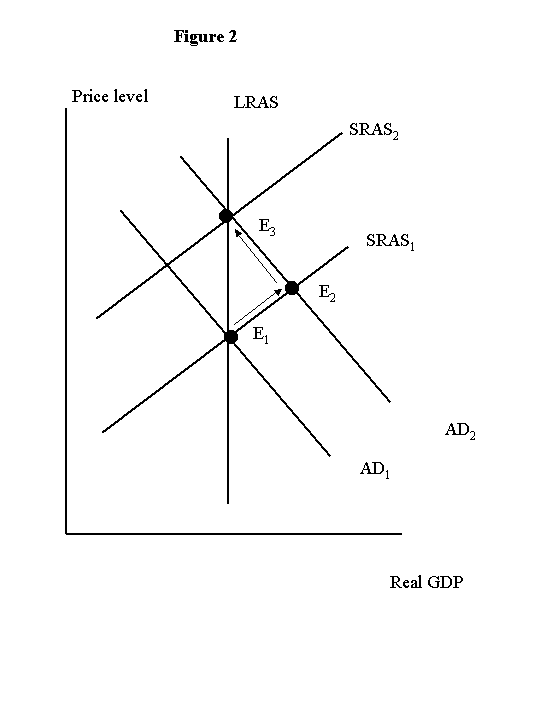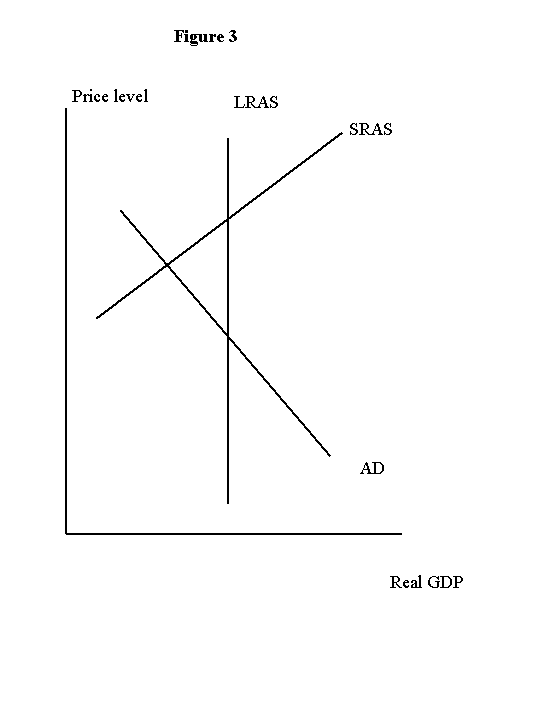SYNOPSIS: This piece, which is a companion to this one, and both address some critics' false accusations of arithmetic problems in his 4.22.03 NYT piece.
The recent confusion over how to think about tax cuts, government spending,
and job creation suggests that I should write down more explicitly how
I think about the issue. It is, quite literally, Econ 101 stuff - in fact,
it's pretty much the way the issue appears in all major principles books.
But it apparently needs to be restated.
So let's begin with a standard aggregate-supply-aggregate-demand picture
of the economy - see, for example, Mankiw's 3rd edition, Chapter 33. I
show that standard model in Figure 1:

Here AD is the aggregate demand curve, SRAS the short-run aggregate
supply curve, LRAS the long-run aggregate supply curve. LRAS is vertical:
changes in the price level have no effect on output in the long run. But
the SRAS curve is probably very flat.
In Figure 1, equilibrium is at E. This is both a short-run and a long-run
equilibrium.
Now let's suppose that there is a positive shock to aggregate demand,
say from either a tax cut or increased government spending. The effect
is to shift AD to the right, as in Figure 2:

The immediate effect is to shift aggregate demand from AD1
to AD2 , leading to a move from E1 to E2
. So output and employment rise at first. But then, over time, the aggregate
supply curve shifts upward, and output returns to its original level. (See,
for example, Mankiw, p. 744). So the effect of fiscal expansion - or, for
that matter, monetary expansion - on employment is only temporary.
Update: Yes, this means that the output and employment increase created
by a fiscal expansion goes away - the additional jobs are here today, gone
tomorrow. Don't take my word for it - check any major principles textbook.
Tax cuts may create jobs, but the jobs go away even if the tax cut remains
in place. "in the long run, shifts in aggregate demand affect the overall
price level but do not affect output." Mankiw, p. 744.
Is that why I don't think that the Bush plan, or any stimulus proposal,
will raise employment on a sustained basis? It's part of the story - but
there's actually more to it.
Look again at Figure 2. Would the Fed sit still while a fiscal expansion
leads to inflation? No, it wouldn't. Under normal circumstances the whole
process shown in Figure 2 would be short-circuited by Fed action: the Fed
would tighten monetary policy to offset the fiscal expansion - as it did
in the 1980s - moving AD right back to its starting position. Because we
have an active monetary policy, under normal conditions fiscal policy doesn't
add to employment even in the short run.
Yet there are conditions under which fiscal expansion can contribute
to job creation. First of all, the economy must be depressed, so that an
increase in aggregate demand moves us back to potential output, not away
from it, as in Figure 3:

But there's more. We have to ask why the economy is in such a position.
Why doesn't the Fed, which can act much more quickly than fiscal policy,
act to push AD up?
The answer is that there must be some constraint on Fed action - such
as the fact that interest rates are already almost as low as they can go.
In short, the case for fiscal policy as a way to create jobs is pretty
much restricted to situations in which the economy is depressed and
is close to a liquidity trap, with real doubts about whether monetary policy
by itself can restore full employment.
Now we are indeed in just such a situation right now. How long will
it last? Nobody knows, but the general assumption is that it will be a
short-lived state - that is, that we aren't heading for a Japan-style sustained
slump. If that assumption is right, the job creating effects of any fiscal
expansion will be of short duration, a year or two; it's just silly to
imagine that the Bush plan, or any plan, will raise employment for 10 years,
let alone raise employment by a growing amount over a decade. And the obvious
policy implication is that fiscal expansion should be temporary, not permanent.
Update again: this means that the fiscal stimulus raises employment
relative to what it would otherwise have been only while the liquidity
trap lasts. Again, the jobs go away.
You may argue that tax cuts are good for some other reason - say, that
they have a supply-side effect, increasing potential output (that is, shifting
LRAS to the right.) But aside from the fact that independent economists
- even the hand-picked head of the CBO - don't agree, that's playing dirty:
if it's about jobs, it's about jobs.
The bottom line: there's a very good reason why I compared the annual
cost of employing a worker with the 10-year cost of the Bush plan. When
the NY Times starts letting me put diagrams in my columns, I'll consider
offering fuller explanations.
But did I mention that the jobs go away? Jeez.
Originally published on the Official Paul Krugman Page, 4.28.03


